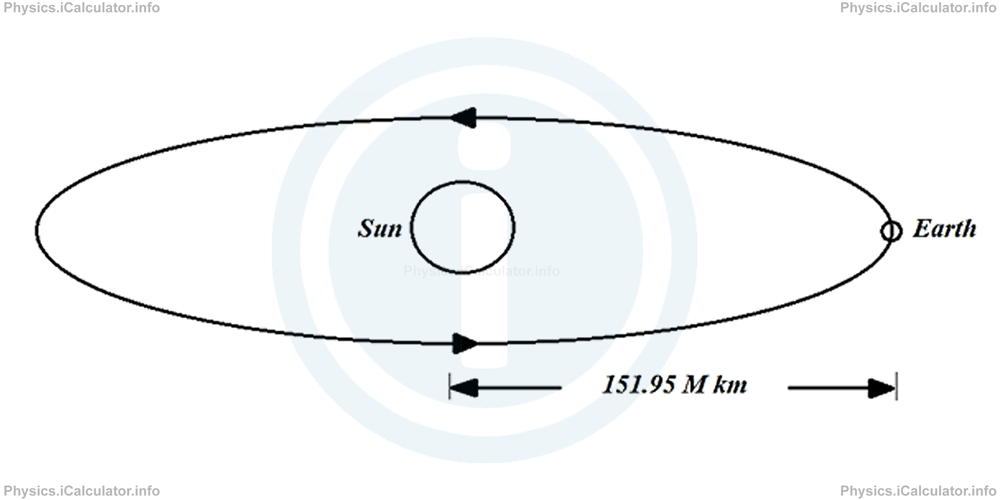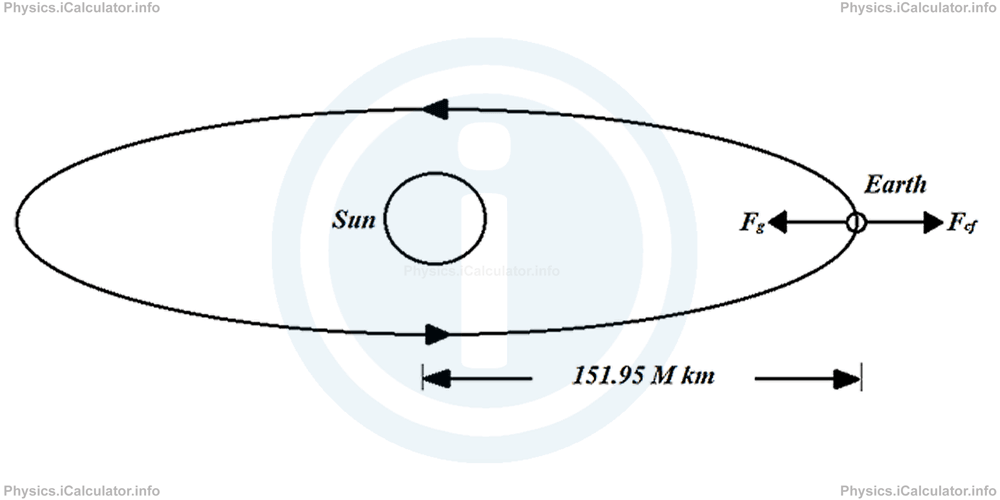Menu
Physics Lesson 8.1.3 - What Makes Objects Rotating in Orbits?
Please provide a rating, it takes seconds and helps us to keep this resource free for all to use
Welcome to our Physics lesson on What Makes Objects Rotating in Orbits?, this is the third lesson of our suite of physics lessons covering the topic of Newton's Law of Gravitation, you can find links to the other lessons within this tutorial and access additional physics learning resources below this lesson.
What Makes Objects Rotating in Orbits?
Since the attraction force between Sun and Earth is that big as seen in the above example, then why they don't collapse?
There are two factors, which prevent such a collapse. First, the presence of other celestial bodies around, produces other gravitational forces that tend to balance the gravitational force produced by the Sun. Second, the centripetal force produced when the Earth rotates around the Sun, makes the Earth rotate in a fixed circular path known as orbit.
Since centripetal and gravitational force have the same direction (both of them point towards the centre of curvature, it seem that they help each other. To fix this issue, we will use here the concept of centrifugal force, Fcf, which in essence is the same as centripetal force but in the opposite direction, i.e. it is a kind of reaction force. Thus, during a rotation in an orbit, the gravitational force is balanced by the centrifugal force. This helps us calculate the velocity of rotation necessary to keep an object (usually celestial bodies) moving in orbits.
Example 2
Calculate the period of Earth revolution around the Sun if they were the only two celestial bodies in the universe. Take the known values: MS = 1.989 × 1030 kg, ME = 5.972 × 1024 kg and RS-E = 151.95 million km.
Solution 2
Considering the Sun as stationary, it is obvious that equilibrium is ensured when gravitational force by which the Sun attracts the Earth towards itself is balanced by the centrifugal (the opposite of centripetal) force by which Earth tries to resist this approach to the Sun. These forces are equal in magnitude and opposite in direction, as shown in the figure below.

Let's write the clues first, by making the proper conversions in the units. Thus,
ME = 5.972 × 1024 kg
RS - E = 151.95 million km = 1.5195 × 1011 m
G = 6.674 × 10-11 N × m2 / kg2
Given that numerically we have
Or
we obtain after simplifications and substitutions,
vEarth = √G × MSun/RSun-Earth
= √6.674 × 10-11 × 1.989 × 1030/1.5195 × 1011
= √8.736 × 108
= 2.9557 × 104 m/s
= 29557 m/s
This is a constant value as all celestial bodies rotate uniformly around their own centre of rotation. Therefore, we must use the equation of uniform motion
where L is the path length and t is the moving time, to determine the period. Here we have
= 2 × π × RSun-Earth
= 2 × 3.14 × 1.5195 × 1011 m
= 9.54246 × 1011 m
Also, we insert the period of rotation T instead of time t in calculations because we are interested for one revolution only (see the Physics tutorial on Kinematics of Rotational Motion). Thus, we obtain
= 9.54246 × 1011 m/2.9557 × 104m/s
= 3.2284940 × 107 s
= 32 284 940 s
Comparing this value with the true period or Earth revolution around the Sun (365.25 d × 24 h/d × 60 min/h × 60 s/min = 31 557 600 s), we observe that the difference is very small. Therefore, we draw as a conclusion that the other celestial bodies do not affect so much the process of Earth revolution around the Sun. This is because either they are very small compared to the Sun (the other planets or natural satellites of our solar system), or they are very far away from us (the other stars in the universe).
You have reached the end of Physics lesson 8.1.3 What Makes Objects Rotating in Orbits?. There are 5 lessons in this physics tutorial covering Newton's Law of Gravitation, you can access all the lessons from this tutorial below.
More Newton's Law of Gravitation Lessons and Learning Resources
Whats next?
Enjoy the "What Makes Objects Rotating in Orbits?" physics lesson? People who liked the "Newton's Law of Gravitation lesson found the following resources useful:
- Rotation Feedback. Helps other - Leave a rating for this rotation (see below)
- Gravitation Physics tutorial: Newton's Law of Gravitation. Read the Newton's Law of Gravitation physics tutorial and build your physics knowledge of Gravitation
- Gravitation Revision Notes: Newton's Law of Gravitation. Print the notes so you can revise the key points covered in the physics tutorial for Newton's Law of Gravitation
- Gravitation Practice Questions: Newton's Law of Gravitation. Test and improve your knowledge of Newton's Law of Gravitation with example questins and answers
- Check your calculations for Gravitation questions with our excellent Gravitation calculators which contain full equations and calculations clearly displayed line by line. See the Gravitation Calculators by iCalculator™ below.
- Continuing learning gravitation - read our next physics tutorial: Gravitational Potential Energy. Kepler Laws
Help others Learning Physics just like you
Please provide a rating, it takes seconds and helps us to keep this resource free for all to use
We hope you found this Physics lesson "Newton's Law of Gravitation" useful. If you did it would be great if you could spare the time to rate this physics lesson (simply click on the number of stars that match your assessment of this physics learning aide) and/or share on social media, this helps us identify popular tutorials and calculators and expand our free learning resources to support our users around the world have free access to expand their knowledge of physics and other disciplines.